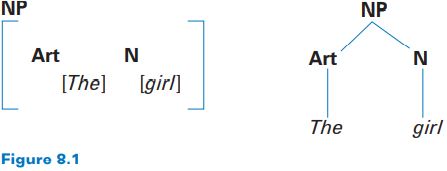


 Grammar
Grammar
 Tenses
Tenses
 Present
Present
 Past
Past
 Future
Future
 Parts Of Speech
Parts Of Speech
 Nouns
Nouns
 Verbs
Verbs
 Adverbs
Adverbs
 Adjectives
Adjectives
 Pronouns
Pronouns
 Pre Position
Pre Position
 Preposition by function
Preposition by function 
 Preposition by construction
Preposition by construction
 Conjunctions
Conjunctions
 Interjections
Interjections
 Grammar Rules
Grammar Rules
 Linguistics
Linguistics
 Semantics
Semantics
 Pragmatics
Pragmatics
 Reading Comprehension
Reading Comprehension|
Read More
Date: 2023-11-10
Date: 2023-05-19
Date: 2023-12-16
|
Tree diagrams
One of the most common ways to create a visual representation of syntactic structure is through tree diagrams. We can use the symbols introduced in Chapter 7 (Art = article, N = noun, NP = noun phrase) to label parts of the tree as we try to capture the hierarchical organization of those parts in the underlying structure of phrases and sentences. So, we can take the information in a labeled and bracketed format, shown on the left, and present it in a tree diagram, shown on the right.
Although this kind of “tree,” with its “branches,” shown on the right, seems to grow down rather than up, it functions rather well as a diagram representing all the grammatical information found in the other analysis on the left. It also shows very explicitly that there are different levels in the analysis. That is, there is a level of analysis at which a constituent such as NP is represented and a different, lower, level at which a constituent such as N is represented. This type of hierarchical organization can be illustrated in a tree diagram for a whole sentence, beginning at the top with S.


If we start at the top of the tree diagram, we begin with a sentence (S) and divide it into two constituents (NP and VP). In turn, the NP constituent is divided into two other constituents (Art and N). Finally, one word is selected that fits the label Art (the) and another that fits N (girl). You can go through the same procedure with the VP branches.
|
|
|
|
دخلت غرفة فنسيت ماذا تريد من داخلها.. خبير يفسر الحالة
|
|
|
|
|
|
|
ثورة طبية.. ابتكار أصغر جهاز لتنظيم ضربات القلب في العالم
|
|
|
|
|
|
|
أصواتٌ قرآنية واعدة .. أكثر من 80 برعماً يشارك في المحفل القرآني الرمضاني بالصحن الحيدري الشريف
|
|
|